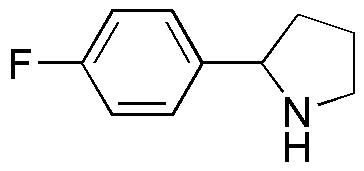2-(4-Fluorophenyl)pyrrolidine is widely utilized in research focused on:
- Pharmaceutical Development: This compound serves as a key intermediate in the synthesis of various pharmaceuticals, particularly in the development of drugs targeting neurological disorders.
- Neurotransmitter Studies: It is used in studies related to neurotransmitter systems, helping researchers understand the effects of compounds on brain function and behavior.
- Analytical Chemistry: The compound is employed in analytical methods to detect and quantify related substances in biological samples, aiding in drug testing and toxicology.
- Material Science: It finds applications in the development of novel materials, particularly in the synthesis of polymers that require specific functional properties.
- Biochemical Research: This chemical is used in various biochemical assays to explore enzyme interactions and metabolic pathways, providing insights into cellular processes.
General Information
Properties
Safety and Regulations
Applications
2-(4-Fluorophenyl)pyrrolidine is widely utilized in research focused on:
- Pharmaceutical Development: This compound serves as a key intermediate in the synthesis of various pharmaceuticals, particularly in the development of drugs targeting neurological disorders.
- Neurotransmitter Studies: It is used in studies related to neurotransmitter systems, helping researchers understand the effects of compounds on brain function and behavior.
- Analytical Chemistry: The compound is employed in analytical methods to detect and quantify related substances in biological samples, aiding in drug testing and toxicology.
- Material Science: It finds applications in the development of novel materials, particularly in the synthesis of polymers that require specific functional properties.
- Biochemical Research: This chemical is used in various biochemical assays to explore enzyme interactions and metabolic pathways, providing insights into cellular processes.
Documents
Safety Data Sheets (SDS)
The SDS provides comprehensive safety information on handling, storage, and disposal of the product.
Product Specification (PS)
The PS provides a comprehensive breakdown of the product’s properties, including chemical composition, physical state, purity, and storage requirements. It also details acceptable quality ranges and the product's intended applications.
Certificates of Analysis (COA)
Search for Certificates of Analysis (COA) by entering the products Lot Number. Lot and Batch Numbers can be found on a product’s label following the words ‘Lot’ or ‘Batch’.
*Catalog Number
*Lot Number
Certificates Of Origin (COO)
This COO confirms the country where the product was manufactured, and also details the materials and components used in it and whether it is derived from natural, synthetic, or other specific sources. This certificate may be required for customs, trade, and regulatory compliance.
*Catalog Number
*Lot Number
Safety Data Sheets (SDS)
The SDS provides comprehensive safety information on handling, storage, and disposal of the product.
DownloadProduct Specification (PS)
The PS provides a comprehensive breakdown of the product’s properties, including chemical composition, physical state, purity, and storage requirements. It also details acceptable quality ranges and the product's intended applications.
DownloadCertificates of Analysis (COA)
Search for Certificates of Analysis (COA) by entering the products Lot Number. Lot and Batch Numbers can be found on a product’s label following the words ‘Lot’ or ‘Batch’.
*Catalog Number
*Lot Number
Certificates Of Origin (COO)
This COO confirms the country where the product was manufactured, and also details the materials and components used in it and whether it is derived from natural, synthetic, or other specific sources. This certificate may be required for customs, trade, and regulatory compliance.


